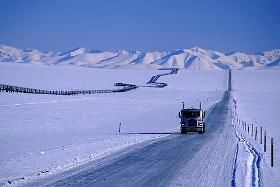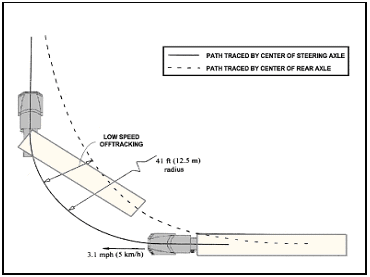Two Right Turn Lanes....
Topic 20598 | Page 3
I've seen plenty of cars with tandem tire rub marks on their drivers side, which comes from them trying to pass on the right.
You have?? I must have missed those somehow.
I'm more worried about 4 wheelers getting on my blind side than a 4 wheeler coming up on my driver's side after I've already started my turn.
Part of the problem here, and I think Errol can attest to this, is geometry. People aren't very good at understanding angles and the like.
When you're making a right hand turn, the driver's side of the trailer is your blind side. Think about where your mirrors are pointing when the tractor is turned to the right. You can't see the left side of your trailer, but you can see the right side in your spot mirror.
I've been trying to avoid this, but I see I'm obviously going to have to make a diagram to explain this.
In all seriousness, I'm a bit concerned that people with considerable driving experience haven't thought this stuff through a little better at this point. This is the kind of stuff Top Tier Drivers should have figured out pretty quickly.
Tandem:
Tandem Axles
A set of axles spaced close together, legally defined as more than 40 and less than 96 inches apart by the USDOT. Drivers tend to refer to the tandem axles on their trailer as just "tandems". You might hear a driver say, "I'm 400 pounds overweight on my tandems", referring to his trailer tandems, not his tractor tandems. Tractor tandems are generally just referred to as "drives" which is short for "drive axles".
HOS:
Hours Of Service
HOS refers to the logbook hours of service regulations.The thing is, I have thought it through. The Kentucky manual is horrible and you're correct, it doesn't cover a two lane right turn lane at all which is why I had questioned it when I was in CDL school. Now we all (hopefully) understand that CDL school and the Real World we drive in daily are NOT THE SAME.
So when a Kentucky DOT officer and I were talking, I asked him for clarification. He came to our school and discussed it. The officer said the main thing is to take your time and protect your blind side from cars trying to sneak past on your right by keeping your trailer close to the curb as you make your turn. He also said if we did not complete a right turn like that, whether one or two turn lanes, we would fail our road test.
I drive in Chicago several days a week. Most (not all) truck routes have plenty of room for taking right turns in the lane farthest to the right. If it's tight, you wait for the cars in the right-turn lane to your left to complete their turn then slowly proceed with making your right turn and protect your right side as you do so.
All I'm saying is FOR YOUR TESTING, do it how it's required in the state you'll be testing in. After that,do what makes the most sense to you for the impending turn and most of all BE SAFE.
CDL:
Commercial Driver's License (CDL)
A CDL is required to drive any of the following vehicles:
- Any combination of vehicles with a gross combined weight rating (GCWR) of 26,001 or more pounds, providing the gross vehicle weight rating (GVWR) of the vehicle being towed is in excess of 10,000 pounds.
- Any single vehicle with a GVWR of 26,001 or more pounds, or any such vehicle towing another not in excess of 10,000 pounds.
- Any vehicle, regardless of size, designed to transport 16 or more persons, including the driver.
- Any vehicle required by federal regulations to be placarded while transporting hazardous materials.
DOT:
Department Of Transportation
A department of the federal executive branch responsible for the national highways and for railroad and airline safety. It also manages Amtrak, the national railroad system, and the Coast Guard.
State and Federal DOT Officers are responsible for commercial vehicle enforcement. "The truck police" you could call them.
What Brett is saying about the mirrors is what is key to this discussion. You can't see anything that is going on over on the outside edge of your vehicle in a turn. That is why you want to be in the outside lane.
The officer said the main thing is to take your time and protect your blind side from cars trying to sneak past on your right by keeping your trailer close to the curb as you make your turn.
This is what I don't get about the officer's explanation. Because in a right hand turn your left side becomes your blind side.
The thing is, I have thought it through.
Then explain this to me:
If it's tight, you wait for the cars in the right-turn lane to your left to complete their turn then slowly proceed with making your right turn and protect your right side as you do so.
How can you see the cars to your left when your tractor is pointing to the right?

This drawing is for something else, but you can see two important things.

1. You can see that in a right turn, the driver (left) side is blind.
2. The offtracking will mess up anything on the right side, so you'd better be watching those mirrors. There are three over there, you need them all. Stay on the outside lane of two lanes - the "inner" cars can move. If you're on the inner lane, the signal pole isn't moving.
You don't need to worry about cars on your left, since you are really moving away from them. But on the right (inside) it's crunch time if you don't pay attention. This is the place where drivers might "sneak" in of you're not paying attention.
Incidentally, a driver in Dallas tried to move in on my left side while I started a legal left turn. I just turned the steering in tighter a bit, then stopped until the genius backed out.
DOT:
Department Of Transportation
A department of the federal executive branch responsible for the national highways and for railroad and airline safety. It also manages Amtrak, the national railroad system, and the Coast Guard.
State and Federal DOT Officers are responsible for commercial vehicle enforcement. "The truck police" you could call them.
HOS:
Hours Of Service
HOS refers to the logbook hours of service regulations.Reading Errol's diagram, I'd say outside is always best for right hand turns at the very least. The off tracking of the trailer makes it so that, when on the inside, you will either A. have to go too far into the oncoming lane of the road you are turning onto, or B. your trailer will clip the inside. Also, then you have to protect your left which does become your blind side, andd you can't see when someone is coming. SO I'd say outside for right, and most likely for left as well.
If you have 2 right turn lanes, you normally shouldn't need to worry about a car trying to pass on the right, considering both lanes are turning right.
But if the right lane can be used as a through lane, and is not a turn specific lane, then I would think I need to use the right lane. Is this correct?
New Reply:
New! Check out our help videos for a better understanding of our forum features

















Preview:
This topic has the following tags:
Safe Driving Tips Truck Driver Safety Understanding The Laws







 TT On Facebook
TT On Facebook
Bumping this...
CDL:
Commercial Driver's License (CDL)
A CDL is required to drive any of the following vehicles: